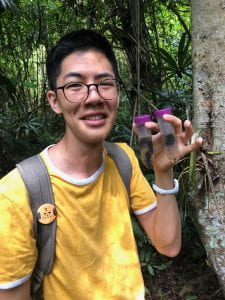Today’s general agenda: project P —> presenting project P —> lectures
Right before we were about to head out to collect our vials in the forest, we had an unforeseen circumstance. This situation was probably one of the most unique situations I have been in- we were stopped by two Scarlet Macaws that were roaming around the research station. We looked at them through the scope once again, and this time I was able to capture their interaction on camera! It’s hard to imagine having your plans delayed because of Scarlet Macaws but that is essentially what happened.

I was the first to collect my samples and boy was I surprised. My urine sample actually had two beetles in them! We took all our vials back, and, as part of our methodology, I was tasked to examine and group ants that shared similar body structures. Through a microscope, I was actually able to look super closely at the facial and body structure of the ants that we collected. Keegan’s vials contained a Strumigenys ludia, which is this really small ant, roughly 2.5mm, with a yellow coloration. In total, I sorted the ants into 16 different groups or morphospecies. We unfortunately were not able to draw any definitive conclusions for our research because we need more data points to support our question.

Prior to this trip, most of us were not too familiar with each other, but I was so impressed how we were able to put together a presentation. I think having to pee in vials definitely brought our whole group closer together as well. Tonight was also the night that I gave my presentation on ants to the class. After learning so much about ants in such a short period of time, I was able to draw connections to my presentation. I am very lucky to have very supportive classmates, and hearing their presentations have been so much fun. Moving forward, I look forward to presenting my other two presentations on sponges and coral reef formation.
Brendan Wong
Las Cuevas, Belize
5/18/2019











